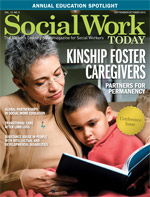|
Building Bridges Research indicates that social work degrees are the most appropriate education for working the field of child welfare and have been associated with improved outcomes for children, families, and staff retention. The child welfare field has faced myriad obstacles over the decades, including stressful (and sometimes dangerous) work environments, large caseloads, and limited training, support, and supervision—all factors affecting the recruitment and retention of qualified social work staff. Nonetheless, social workers prevail in child welfare by building bridges to a better system through advocacy, policy planning, and continuous improvement of practice standards in a system influenced by complex social, economic, political, and cultural changes. NASW led the field in developing standards for social work practice in child welfare and periodically revises them to meet current practice trends and reflect professional values. The 2013 standards continue to embrace permanency planning, the process that aims to limit placement into and time spent in out-of-home care. One permanency planning option—kinship foster care—is the topic of this issue’s cover story. The majority of kinship caregivers are not formally connected to the child welfare system for various cultural, social, and familial reasons, which the story discusses. Recognizing the challenges posed by kinship caregivers’ informal status, the Fostering Connections to Success and Increasing Adoptions Act of 2008 resulted in a range of services and programs aimed at informal kinship foster care providers, but concerns remain for those kinship caregivers who choose to remain unconnected to the formal child welfare system. In 2011, a National Kinship Summit was convened, and among its recommendations identified as critical in meeting the needs of these families was increased access to information for all types of kinship foster care providers. The summit encouraged the child welfare system to engage all kinship care providers and establish kinship navigator programs in every state. Such programs are described in our cover story as linking kinship providers with information about services, including financial assistance, respite care, food and housing assistance, medical services, counseling, mentoring, training, education, and support groups. Engaging formal and informal kinship care providers is a process that integrates several of the social work practice standards in child welfare, including permanency planning, collaboration, and family engagement. Social workers prevail in child welfare by building bridges to a better system, and a better system helps build—and sometimes repair—bridges to family unity and preservation. We welcome your feedback at SWTeditor@gvpub.com. |

 September/October 2013 Issue
September/October 2013 Issue